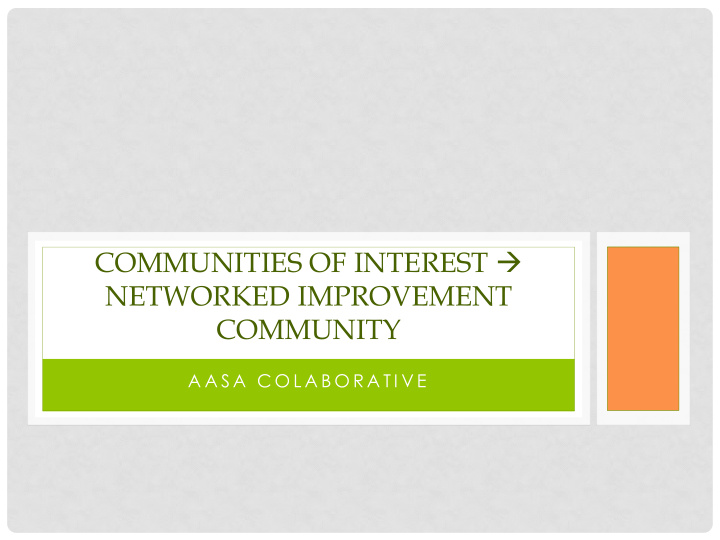



COMMUNITIES OF INTEREST NETWORKED IMPROVEMENT COMMUNITY A A S A C O L A B O R A T I V E
BRYK ET AL., CARNEGIE FOUNDATION FOR THE ADVANCEMENT OF TEACHING: • Our current R&D infrastructure is inadequate; • A more problem-based approach that joins academic research & clinical practice to an action research orientation that focuses on systematic inquiry-based work is critical
But We Live in an Incoherent Environment for Improvement A Dense Array of Fragmented Activity Key: = Individual Researcher = Individual Practitioner
“The Horizon” The current educational Ambitious Learning R&D system will not get us For All Students to our goals More Efficient Systems Networked improvement communities needed • Problems of Practice Improvement Focus • Rapid prototyping-test-refine-retry (Engineering) • Co-development in an open resources environment • Not just can it work; How to make it work reliably
CARNEGIE’S CORE PRINCIPLES FOR IMPROVEMENT • Make the work problem-specific and user-centered. It starts with a single question: “What specifically is the problem we are trying to solve ?” • Variation in performance is the core problem to address. The critical issue is not what works, but rather what works, for whom and under what set of conditions. Aim to advance efficacy reliably at scale. • See the system that produces the current outcomes. It is hard to improve what you do not fully understand. Go and see how local conditions shape work processes. Make your hypotheses for change public and clear. • We cannot improve at scale what we cannot measure. Embed measures of key outcomes and processes to track if change is an improvement. • Anchor practice improvement in disciplined inquiry . Engage rapid cycles of Plan, Do, Study, Act (PDSA) to learn fast, fail fast, and improve quickly. That failures may occur is not the problem; that we fail to learn from them is. • Accelerate improvements through networked communities. Source: http://www.carnegiefoundation.org/improvement-research/approach
NETWORKED IMPROVEMENT COMMUNITIES • “Networks enable individuals from many different contexts to participate according to their interests and expertise while sustaining collective attention on progress toward common goals .” • “A networked improvement community is a distinct network form that arranges human and technical resources so that the community is capable of getting better at getting better ” • NICs are “a case of learning by doing”
THREE KEY QUESTIONS • What problem(s) are we trying to solve? • Whose expertise is needed to solve these problems? • What are the social arrangements that will enable this work? • NIC’s Integrate Two Big Ideas: • The rudiments of Improvement Science • The Power of Networks “ Accelerating learning in and through practice to improve”
AN IMPROVEMENT NETWORK ORGANIZED AROUND SOLVING PROBLEMS – A common analytic frame for organizing local improvements – Common measures (student background, processes, and outcomes) to inform continuous improvement – A shared technical capacity to support and build local capacity – Linked together in a community of participation (face-to-face and web 2.0)
“STRUCTURING AGENTS” • NICs generally do not arise organically, but rather require leadership and nurturing. • Networks require “structuring agents” to help define rules for membership and collective action • “A networked improvement community is an intentionally formed social organization. Its improvement goals impose specific demands on the rules and norms of participation .” • The AASA Collaborative = structuring agent
WHAT IS AN NIC? A WORKING DEFINITION An NIC is a group of people who share a common puzzle or challenge, and who exchange knowledge, skills, and resources in pursuit of a greater understanding and a means to resolve this puzzle or challenge.
An Improvement Network Organized Around Solving the Problem Program Improvement Map Core R&D Relationships R&D Relationships Enhanced/Scaled via Commercial An Open Resources Infrastructure Partnerships
WHO ARE THE MEMBERS OF OUR NICS? Superintendents (and/or designees) who seek collaborators in solving problems of student learning.
HOW DO WE SEE THIS WORKING? Members join together based Problem or on problem or puzzle puzzle Knowledge Likely Evaluation building causes Critical friends Solution Identify Potential and/or approaches solutions advocacy likely to work
LIKELY BENEFITS • Clearer specification of puzzles or problems • Better analysis better decisions • Increased knowledge sharing greater learning • Process reinforces key leadership proficiencies (collaboration, problem solving, knowledge sharing) • Networking reduced sense of isolation • Spill-over partnerships – collaboration on issues or puzzles other than the initial one(s)
HOW DOES IT “FIT”? NICs are study teams consisting of superintendents wishing to learn from one another, supported by… • Site visits to help identify issues or puzzles of import [The initial puzzle or problem might emerge from feedback obtained through site visits] • Consultancies by which a community is served by external experts • Shared professional development opportunities • Critical friends who visit one another to help study the problem or puzzle in other districts
Recommend
More recommend